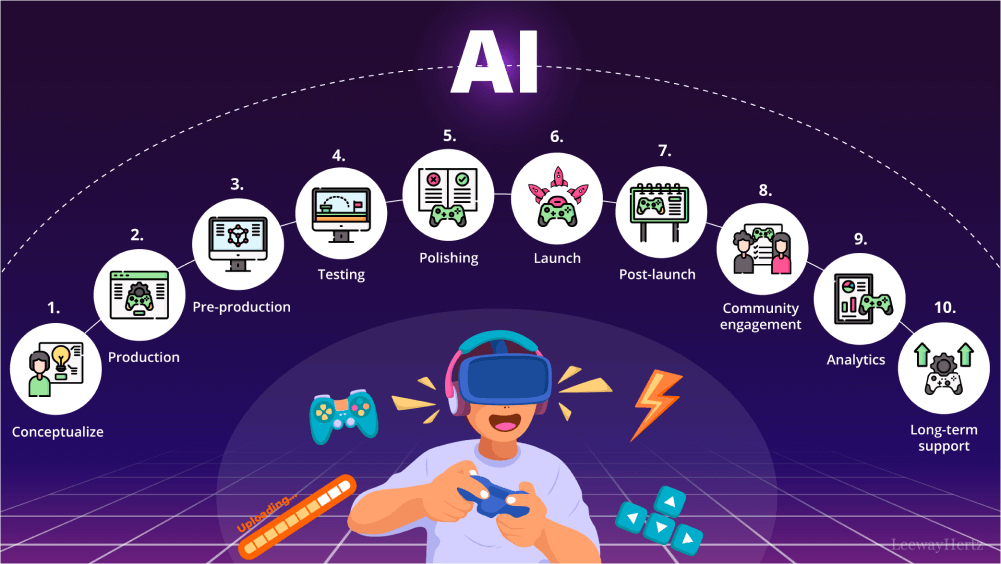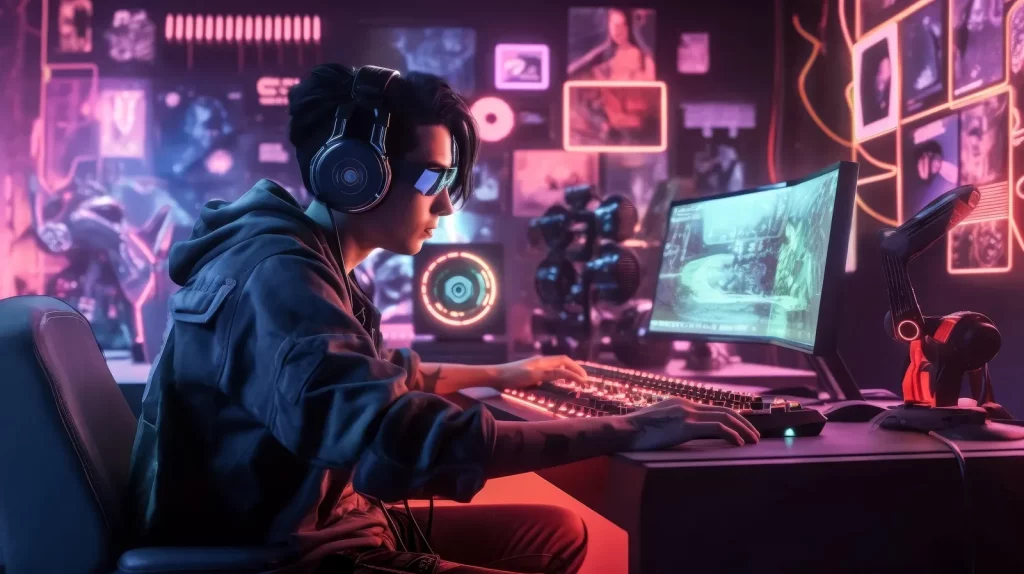Artificial Intelligence (AI) is rapidly transforming the gaming industry by enhancing player experiences, streamlining game development, and even shaping the future of interactive entertainment. Here’s a look at some key use cases, applications, implementation, and emerging trends in AI within gaming.
Use Cases of AI in Gaming
- Non-Player Character (NPC) Behavior:
AI is used extensively to control NPCs, making them appear more realistic and reactive. In many games, NPCs exhibit adaptive behaviors that mimic human decision-making, responding to player actions with increased complexity. Games like The Last of Us and Red Dead Redemption 2 use AI to create more lifelike characters with deep interaction mechanics and emotional responses. - Procedural Content Generation:
AI-driven procedural generation is often used to create massive game worlds without requiring developers to manually design every element. No Man’s Sky is a notable example, where AI algorithms generate planets, flora, fauna, and ecosystems on the fly, offering players an almost infinite variety of gameplay experiences. - Personalized Gaming Experiences:
AI can personalize gaming experiences by adjusting difficulty based on player skill level. Games can detect player behavior and modify AI opponents’ strategies or environmental challenges to maintain a balanced experience. This is seen in Left 4 Dead, where AI adjusts the intensity of the zombie hordes based on player performance. - AI in Game Testing:
AI is used in automating game testing, helping developers identify bugs, glitches, and performance issues more efficiently than traditional manual testing. AI tools can simulate player behavior to uncover rare bugs that would otherwise take human testers much longer to identify.
Applications of AI in Gaming
- AI-Driven Graphics Rendering:
AI can be used to enhance graphics and textures. Techniques like DLSS (Deep Learning Super Sampling) in NVIDIA’s GPUs use AI to upscale lower-resolution images in real-time, allowing games to run at higher frame rates while maintaining visual quality. This has been implemented in titles such as Cyberpunk 2077 and Control. - Voice and Language Processing:
AI enhances voice recognition and language processing within games, allowing for natural language interactions. In Star Wars Jedi: Fallen Order, AI enables players to issue voice commands, making interactions with game characters more fluid and intuitive. AI is also used for dynamic dialogue systems where characters can respond differently based on player choices. - AI-Powered Storytelling:
AI can also be used to drive dynamic and reactive storylines, where the narrative evolves based on player actions and decisions. This approach is seen in Detroit: Become Human, where AI helps shape the outcomes of branching narratives, providing a unique experience for every player.
Implementation of AI in Game Development
- Game Design Assistance:
AI tools can assist game designers by automatically generating complex levels, designing characters, and even balancing gameplay. By analyzing player data, AI can suggest alterations to improve player retention or in-game experience. - AI in Game Development Tools:
Several AI-powered development tools, such as Unity ML-Agents and Unreal Engine’s AI framework, allow developers to integrate machine learning into their games easily. These tools help automate NPC behaviors, streamline AI testing, and simulate environments without intensive manual effort. - Adaptive AI and Machine Learning:
In many modern games, machine learning models are used to adjust game parameters dynamically. For instance, in sports or racing games, the AI can learn from the player’s previous moves and adapt its strategy to provide a constantly evolving challenge, ensuring that the experience remains fresh and engaging.
Trends in AI in Gaming
- Realistic Game Physics and Animation:
As AI improves, we’re seeing more realistic physics and animation systems. AI models are being trained to simulate realistic movements, reactions, and environmental interactions, making games feel more responsive and lifelike. - AI and Virtual Reality (VR):
With the rise of VR gaming, AI is playing a crucial role in enhancing indulgement. AI-driven adaptive systems adjust the game world based on a player’s actions and reactions in real-time, making VR experiences more interactive and engaging. - AI as a Creative Tool:
There’s a growing trend of using AI to assist with creative processes in game design. AI is not just controlling characters and gameplay mechanics but is also helping to create art, music, and even complex narratives. For example, AI Dungeon allows players to engage in a fully procedurally generated story with limitless possibilities. - Cloud Gaming with AI Integration:
Cloud gaming platforms, such as Google Stadia and NVIDIA GeForce Now, are incorporating AI to optimize performance, reduce latency, and personalize gaming experiences in real-time. AI is essential in managing resources on cloud servers to ensure smooth gameplay.
Conclusion: The Future of AI in Gaming
AI continues to push the boundaries of what’s possible in gaming, from creating more realistic and dynamic gameplay to enhancing user experiences through personalization and story progression. As AI technology advances, its integration into gaming will only deepen, offering even better, complex, and responsive gaming environments.
For developers and players, embracing AI will be key in shaping the future of gaming, where the boundaries between player and game blur even further. As AI continues to evolve, the possibilities in game development and player engagement will only grow.



